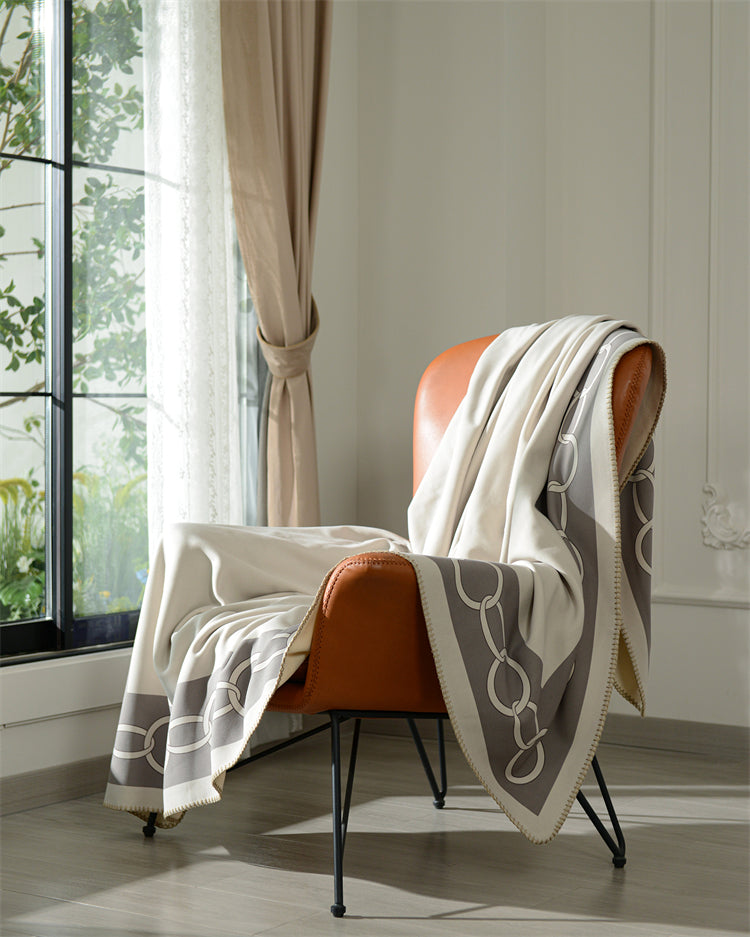Your Cart is Empty
FREE WORLDWIDE DELIVERY FOR ORDERS OVER £75
Blankets have been around since prehistorical times, but the modern blanket seems to have been popularized by Thomas Blanket, a Flemish weaver who made wool blankets. (In fact, his name likely came from his trade, since the word “blanket” already existed.) But today, blankets have come a long way and you will find many types of blankets to choose from.
Though they started as simple coverings made of animal skins and plant material, and later, wool and textiles, we now have blankets of all kinds. You can buy a quilt, a comforter, or a modern weighted blanket, for example. Which should you choose?
In this guide to types of blankets, we’ll help you make the best choices for all your home blanket needs. Here’s what you should know about all the different blanket types on the market today.
First, the basics: there are lots of different types of blankets out there, but these are the primary ones you’re likely to see on the market today.
While blankets are often thought of as being practical items, not all blankets are actually made to keep you warm. The coverlet, for example, is one of the purely decorative blanket types.
A coverlet goes over the top of the bed, without reaching down to the floor or over the pillows. It’s thin and meant for decoration, not warmth. Typically, you’ll put your coverlet over the top of another, more practical blanket.
A quilt can be a type of coverlet, but some quilts are also warmer and more practical. These blankets are decorative, with a patchwork pattern of different fabrics. But thanks to the inner layer of batting, they tend to offer more warmth than the typical coverlet.
Afghans are sometimes put into their own category, but they effectively serve the same purpose as blankets: warmth and decoration.
Afghans are knitted or crocheted, typically using wool or other natural material. These blankets are usually designed to both look nice and keep you warm, but they’re more often tossed over a chair or couch than on a bed.
A duvet is a type of thick, warm blanket that goes on the bed to trap heat underneath. A thick layer of down or other fiber inside the blanket’s covering makes it warm. Duvets need duvet covers, or protective outer shells, to keep them from getting dirty and damaged.
A comforter is much the same as a duvet, but comforters don’t necessarily need covers.
Comforters offer both decoration and warmth since they often come in attractive patterns and colors. Down comforters are popular for their warmth, but less-expensive fillings can also be used.
A bedspread is most similar to a coverlet, but bedspreads are larger. They’re designed to reach the floor and to cover the whole bed, including the pillows. Most bedspreads are thin and aren’t warm, but made to look pretty.
An electric blanket has a heating element inside and plugs into electricity to keep the user warm. These blankets also have built-in temperature controls so you can set them to be warmer or cooler as needed.
Electric blankets are very warm, but can also pose certain hazards. For example, you shouldn’t leave an electric blanket plugged in when you aren’t using it. Damaged wiring can also create a fire hazard, so it’s important to always check electric blankets for damage, and replace them as often as needed.
The weighted blanket is a newly popular trend in blankets. These blankets are designed to be warm, but also heavy, producing a calming effect when you lay beneath one.
The pressure of a weighted blanket can feel like you’re getting a hug. Many people find it physically comforting to lay under a weighted blanket and get better sleep with one.
Some people may place throws and blankets into the same category. However, it’s worthwhile to note that there are some slight differences between the two.
A throw is typically smaller than a blanket and is used for decoration when tossed over a chair or couch, hence the term. Afghans are similar to throws but tend to be larger and warmer, like blankets. But the main difference is the size: afghans and blankets are both usually larger than throws.
When shopping for blankets, you’ll find that there’s a wide range of materials to choose from. Let’s take a look at some of the top materials for blankets and the benefits of each.
Wool is one of the oldest and most beloved blanket materials. Wool is naturally warm and moisture-wicking, so it’s great at keeping you comfortable.
This material also resists fire, so it’s not as dangerous when used close to a heating vent or another source of heat.
Today, acrylic offers a popular alternative to natural materials like wool. It’s light while also keeping you warm. Plus, its soft texture can feel a lot like natural materials but is easier to machine wash. Finally, unlike wool, your acrylic blanket will never attract moths.
When it comes to natural fibers, cotton is another one of the top choices for blanket materials. Cotton blankets are super-soft and breathable, and they’re ideal for hot summer nights when you want a covering that won’t overheat you.
Cotton also blends well with other materials, like polyester. A blend tends to be more durable, while still feeling very soft.
In most homes, multiple types of blankets are needed. You might need blankets for both summer and winter, as well as blankets for different rooms in your home. It’s always better to have too many than not enough!
Trying a few different blanket types also lets you get an idea of which ones you like best. Choosing blankets is largely a matter of personal preference, after all.
Looking for some new blankets for your home? Check out our luxury blankets at The Opal Interior Company
